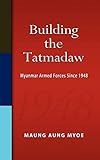Building the Tatmadaw : Myanmar Armed Forces Since 1948 / Maung Aung Myoe.
Material type: TextPublisher: Singapore : ISEAS Publishing, [2009]Copyright date: ©2009Description: 1 online resource (272 p.)Content type:
TextPublisher: Singapore : ISEAS Publishing, [2009]Copyright date: ©2009Description: 1 online resource (272 p.)Content type: - 9789812308481
- 9789812308498
- 355.03309591
- online - DeGruyter
| Item type | Current library | Call number | URL | Status | Notes | Barcode | |
|---|---|---|---|---|---|---|---|
 eBook
eBook
|
Biblioteca "Angelicum" Pont. Univ. S.Tommaso d'Aquino Nuvola online | online - DeGruyter (Browse shelf(Opens below)) | Online access | Not for loan (Accesso limitato) | Accesso per gli utenti autorizzati / Access for authorized users | (dgr)9789812308498 |
Frontmatter -- Contents -- List of Tables -- LIST OF FIGURES -- ACKNOWLEDGEMENTS -- Glossary -- 1. Introduction -- 2. Military Doctrine and Strategy -- 3. Organization and Force Structure -- 4. Armament and Force Modernization -- 5. Military Training and Officer Education -- 6. Financing Force Modernization and Troops Welfare -- 7. Conclusion -- APPENDICES -- Bibliography -- INDEX -- About the Author
restricted access online access with authorization star
http://purl.org/coar/access_right/c_16ec
Ever since Myanmar regained her independence in January 1948, the Tatmadaw (Myanmar Armed Forces) has been crucial in restoring and maintaining law and order. It is one of the most important institutions in Myanmar politics. Various aspects of the Tatmadaw have been studied. The most notable area of study has been the political role of the military. This study looks at the organizational development of the Myanmar armed forces. It analyses four different aspects of the Tatmadaw: military doctrine and strategy, organization and force structure, armament and force modernization, and military training and officer education. It sets out security perceptions and policies, charting developments in each phase against the situation at the time, and also notes the contributions of the leading actors in the process. Since early 1990s, the Tatmadaw has implemented a force modernization programme. This work studies rationales and strategy behind the force modernization programme and examines the military capabilities of the Tatmadaw. Drawing extensively from archival sources and existing literature, this empirically grounded research argues that, while the internal armed security threat to the state continues to play an important role, it is the external security threat that gives more weight to the expansion and modernization of the Tatmadaw since 1988. It also argues that, despite its imperfections, the Tatmadaw has transformed from a force essentially for counter-insurgency operations into a force capable of fighting in limited conventional warfare.
Mode of access: Internet via World Wide Web.
In English.
Description based on online resource; title from PDF title page (publisher's Web site, viewed 01. Dez 2022)


